Badami cave temples are a group of four rock-cut cave temples with exquisite sculptures. These temples are around 1500 years old and attributed to the Chalukya dynasty. These temples are cut into the side of a huge red sandstone mountain and remains as the finest examples of Indian temple architecture and art. One of them is a Shiva temple, the second and third are Vishnu temples and the fourth is a Jain temple.
I planned to visit Badami, Aihole and Pattadakkal from 5th of July to 10th of July 2016. Usually my husband accompanies me on my trips. But this time, he couldn’t make it due to his business travel. I decided to travel with my mother. In the beginning I was apprehensive about it, but it turned out to be a wonderful experience travelling with her. The train from Bangalore to Badami is “Golgumbaz Express”
It is the ideal train for those who are visiting Badami or Bijapur.
As the train started moving slowly out of Bangalore, I felt
so happy and excited. My mother was equally excited as it was our first trip
together. After a comfortable journey, we reached Badami railway station at
7:30 am in the following morning.
Badami town is approximately 5 km from the railway station. Transfer from the railway station to the town is not difficult as there are a lot of autos(tuk-tuk), mini vans doing service between railway station and town. For a charge of 120 rupees, one auto took us to our hotel Mayura Chalukya. It is a hotel run by Karnataka tourism. It is an old property but it’s location is excellent. All the important attractions in are within 2 km from the hotel. The room was quite disappointing. It was old and congested. The A/C did not work. But the hotel staff was courteous enough to upgrade us to a larger and better room, much to my relief.
 |
| We reached Badami! |
Badami town is approximately 5 km from the railway station. Transfer from the railway station to the town is not difficult as there are a lot of autos(tuk-tuk), mini vans doing service between railway station and town. For a charge of 120 rupees, one auto took us to our hotel Mayura Chalukya. It is a hotel run by Karnataka tourism. It is an old property but it’s location is excellent. All the important attractions in are within 2 km from the hotel. The room was quite disappointing. It was old and congested. The A/C did not work. But the hotel staff was courteous enough to upgrade us to a larger and better room, much to my relief.
 |
| Hotel Mayura Chalukya |
After a small rest we were ready for the first part of our
itinerary. The first stop is the Badami Cave temples. The hotel staff told the caves are quite close to the hotel, however we took an auto. I
think it was a great decision. It is not a clean city to walk around. There
are a lot of stray pigs roaming around and the walkways are littered. Also to
reach the caves, one need to cross the Badami slum area, which is
quite untidy. However, as we enter the temple complex, it looks like another world. The complex looks so neat and tidy. Archaeological Survey of India(ASI) is maintain this archaeological site with utmost care and sensitivity.
After purchasing the tickets, we waited for few minutes for our
English speaking guide to arrive. Most of the guides are well versed
with Hindi and Kannada. You need to explicitly ask for an English speaking
guide. Sometimes the guide claims to speak English, but would only throw in a
few English words. So it is better to engage the guide in a small chitchat to
measure the English knowledge. Also, the temple area is notorious for
aggressive monkeys. One need to take caution to avoid these troublesome lot. Thankfully
our guide “Panchu” – that was his name – was an excellent guy. He was a BA in
History and was so passionate about the archaeological sites. He started the
tour with a small story to warm up our interest.
“Chalukyas” were a powerful dynasty that ruled most parts of
North Karnataka from the year AD 544. There is an interesting story behind the
genesis of the name “Chalukya”. Once Brahma – one of the supreme God in Hindu
trinity – was doing his morning prayers. Indra – the King of Gods visited
Brahma with a complaint. He said the people on earth are deviating from faith
and have stopped performing religious rituals. Indra wanted Brahma to bring
people back to faith and holistic living. Suddenly a great warrior and guru
emerged from the water pot of Brahma. This water pot was used for religious
rituals and was known as “Chaluka” in Sanskrit. As the warrior emerged from a
Chaluka(water pot) he was called “Chalukya”. According to the legends, this is
the story of the progenitor of Chalukya dynasty.
Badami Cave Temple 1
 |
| Entrance of cave 1 |
As we walked towards the first cave temple, our guide
explained about the etymology of Badami. According to the ancient inscriptions,
Badami was known as “Vatapipura” or “Vatapi”. The name Badami must be a modern
and alternate version of “Vatapi”. However, there is another theory. It
attributes the name to the almond colored rocks in this area. In Kannada,
almond is called “Badam” and the place with red rocks resembling almonds (even
in texture) was named “Badami”. As we entered into the first cave temple, the first notable sculpture is that of an eighteen handed Shiva.
Sculpture of the Dancing Shiva - Nataraja
Shiva is performing the dance
named “Thandava”. Each hand of Shiva is a symbol from the Indian classical
dance “Bharatanatyam”. Nandi- Shiva’s vehicle - is at his feet along with the drummers and
musicians. There is one drummer on the right side of the Shiva who is of great
interest. He is the attendant named “Tandu”. According to Hindu Mythology,
Shiva instructed Tandu to teach this dance to Sage Bharata(author of Natya
Sastra). Hence this dance took the name “Tandava”. It was a new knowledge to me. The guide also
told that by combining one hand from either side of Shiva, one can see 81 distinctive
poses of Bharanatyam – A famous south Indian classical dance form. Our guide
pointed the complex hairdo of Shiva. It is a characteristic of Badami
sculptures. Every figure has a distinctive hair style.
There is also the sculpture of “Mahishasura Mardini” – The goddess who
slayed the bull shaped demon Mahisha. One thing is noteworthy, how the weapon
of the Goddess is piercing through the head of the bull and touching the
ground. Such an attention to detail is a specialty of Badami sculptures.
Just near the Goddess's sculpture,
there is a small figure of Ganesha. Usually Ganesha is depicted with a pot
belly, however in this sculpture, he is quite slim. This sculpture is in the form
of Vatapi Ganapathi. According to
historians, there was a famous idol of Ganesha in ancient Badami known as the
“Vatapi Ganapathi”. During the Pallava invasion of Badami under the leadership
of great Pallava general Siruthondar , they smuggled this famous idol to Tanjavore – a place now in Tamilnadu. The
ancient idol is still present in Uthrapatheeswarar temple of Tiruchenkattankudi
temple of Tamilnadu.
 |
Vatapi Ganapathi |
Main Bas- Relief in Badami Cave temple 1 - Ardhanarishvara Panel
As we climbed the steps of the
first cave temple, we found ourselves in a long corridor with intricately
carved pillars. Both ends of the corridor is decorated with a magnificent piece
of sculpture. On one side, we have the “Ardhanarishvara”.
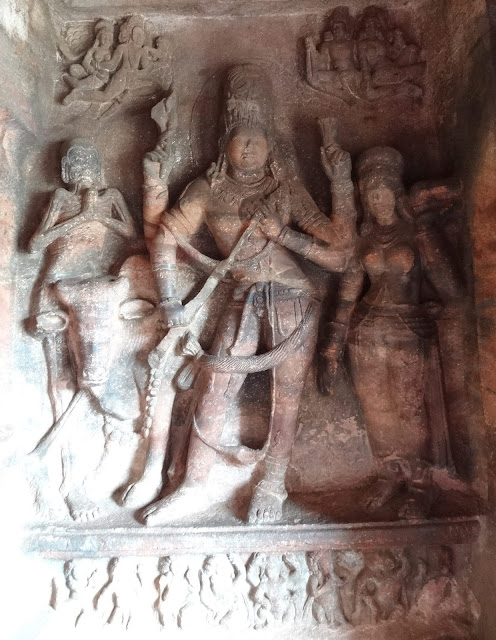 |
| Ardhanarishvara Panel |
It is a form that combines Lord Shiva and his consort
Parvati. One side is of male form and the other side is female. On closer
observation, we can see that the right half has anklet on the leg, other
ornaments and a raised bosom. The hairdo and the ear ring of the right side is
also different. The right side depicts Parvati.
I have seen Ardhanarishvara
depicted on the walls many ancient temples. However, one distinctive feature of
this grand sculpture is a skeletal figure on the left most side of the
sculpture. I wondered how such an austere figure ended up in such a beautiful
sculpture. Our guide had a good laugh at my bizarre question. He told that
skeletal figure is the central to the theme of the sculpture. He is a sage
named Bringi.
Bringi was a great Shiva devotee. But he did not have high
regard for Parvati as she was a woman. Bringi wanted perform Parikrama or
Pradakshina(in Hinduism, the devotee walks around the god in a circle) only
around Shiva. Shiva and Parvati combined their bodies to become Ardhanarishvara
figure so that Bringi cannot do circumambulation around Shiva. Bringi did not
budge, he was so determined to worship only Shiva. This enraged Parvati. She
took back from Bringi, all the vital elements that comes from mother. According
to Hindu philosophy, the hard parts of the body line bone and nerves comes from
the father and the soft parts like flesh and blood from mother. Bringi become a
skeletal figure after the curse of Parvati. This incident is described in this magnificent
sculpture panel. On the right most side of the panel, we can see a women
figure. She is the attendant of Parvati and she is holding a jewel box. According
to our guide, this figure is placed in the panel just to maintain the symmetry.
Bas-relief 2 : Harihara Panel
Another magnificent sculpture panel in the first cave
temple is the Harihara panel. This panel also depicts a similar theme as that
of Arthanareeswara. In Harihara Panel,
the central figure is a combination of “Hari” means Vishnu and “Hara” means
Shiva. In the Harihara form, Shiva and Vishnu are fused to form a single
figure.
Even though both the halves look same, on closer observation, one can see the on the left hand, the idol has an Axe(“Parasu”) and serpent – symbol of Shiva. On right hand it is “Shanka”(A Conch, symbol of Vishnu). Even the hair do is different. Shiva’s side (left) has a small moon depicted. Shiva has a serpent around the waist and an anklet on his leg, but Vishnu side is different. It is a wonder how the sculptors managed to bring about such a details into one sculpture.
 |
| Image of Harihara By Sissssou2 (Flickr: Cave temple) [CC BY-SA 2.0], via Wikimedia Commons |
Even though both the halves look same, on closer observation, one can see the on the left hand, the idol has an Axe(“Parasu”) and serpent – symbol of Shiva. On right hand it is “Shanka”(A Conch, symbol of Vishnu). Even the hair do is different. Shiva’s side (left) has a small moon depicted. Shiva has a serpent around the waist and an anklet on his leg, but Vishnu side is different. It is a wonder how the sculptors managed to bring about such a details into one sculpture.
 |
| HariHara Panel |
Our guide told us that the Harihara form was created to
bring about harmony between Vaishnavists and Shaivists (who follow only Vishnu
or Shiva respectively) There were two groups who fought bitterly in medieval
India. I noticed the highly
carved pillars and roof of the temple. There were flying Gandarvas and Apsaras
on the roof, so intricately carved.
I wondered how much painful it might have been to carve on
the roof. It is not straight forward as carving on a wall. Each sculpture has
the hand print of the sculptor, along with his blood and sweat. The coiled
Nagaraja on the roof is extremely simple yet beautiful.
 |
| Coiled Naga - Roof sculpture |
After seeing the Harihara panel, we entered into the
interiors of cave temple. One thing that was so odd is that, there were no
sculptures or pillar decorations on the inner side of the cave temple. Our
guide explained about it. As they are cave temples, sunlight only falls in the
first corridor. The inner corridor and sanctum would be in shade most of the
times. The sculptors knew that it is not worthwhile making the sculptures
inside as, sunlight it is essential for anyone to appreciate the beauty of a
sculpture. Thus they saved time and energy and spent it on the magnificent
carvings on the front corridor.
As we started walking towards the second cave temple, our
guide shared some more history of the Chalukya dynasty. Chalukya dynasty
originated from two governors of Kadambas. They were Jayasimha and Ranaranga.
They were not independent rules, but the rebelled against the Kadambas. The
first ruler of Chalukya dynasty is Pulakeshi I. He founded the Chalukya empire
in AD 544. He selected Vatapi as his headquarters, mainly due to the secure
geography of Vatapi. Vatapi is surrounded by huge red sandstone cliffs on three
sides. It would be difficult for any enemy to stealthily approach it. Pulakeshi
I also founded a fort on top of the Badami cliffs. The most famous ruler of
Chalukya line is the second Pulakeshi. He was the grandson of Pulakeshi I. He
defeated his uncle Mangalesha and captured the control of Badami. He was an
eminent ruler. He spread the Chalukya dynasty far south towards Maharashtra and
east towards Tamilnadu. There was a time when Chalukyas controlled the entire
Deccan plateau. However the Chalukya dynasty started disintegrating in the late
8th century AD. Kirthivarman II is the last Chalukya king. In AD
757, the Rasktrakutas conquered Chalukyas and gained control over the major
parts of Deccan.
It was Chalukyas who laid the foundation stones of south
Indian sculptures and temple architecture. All the dynasties who followed took
inspiration from the design and architecture from Chalukya temples.
We walked towards the second cave temple. It is smaller
compared to the first one. Second temple is dedicated to Vishnu. Like the first
cave temple, there is a corridor in front of the cave temple, lined by highly
ornate pillars. On either sides of the corridor there are huge sculptural
panels.
Badami cave temple 2 - Bas-Relief 1 - Varaha rescuing Goddess Earth
One of them depicts
the “Varaha Avatar” of Vishnu. In his Varaha Avatar, Vishnu takes the form of a
wild boar. There is a slim lady in Varaha’s hands. It is the Goddess earth.
According to Hindu mythology an Asura named Hiranyaksha abducted Goddess earth
and placed her in abyss. Vishnu in his Varaha Avatar rescued the mother Earth.
This sculptural panel describes this story. There is a coiled serpent near the
foot of Varaha. It is “Sesha Naga” the attendant of Vishnu.
 |
| Varaha Rescuing Goddess Earth - Panel |
Bas-Relief 2- Trivikrama Panel
The next panel is of “Trivikrama”. It is also another Avatar
of God Vishnu. This story is related to a generous Asura King named Mahabali. King
of Gods Indra was jealous of the prosperity of King Mahabali and implored
Vishnu to eliminate Mahabali. Vishnu took the form of a young Brahmin sage and requested
Mahabali to grant him 3-foot land for doing his penance. Mahabali readily
agreed. The moment Mahabali promised this, Vamana grew into a gigantic form –
Trivikrama. With his 2 foot Trivikrama measured earth, abyss and sky. He asked
Mahabali – “Where should I place my third foot?” Mahabali was true to his word.
He showed his head and prayed Vishnu to place his foot. This is the situation
depicted in this sculpture panel.
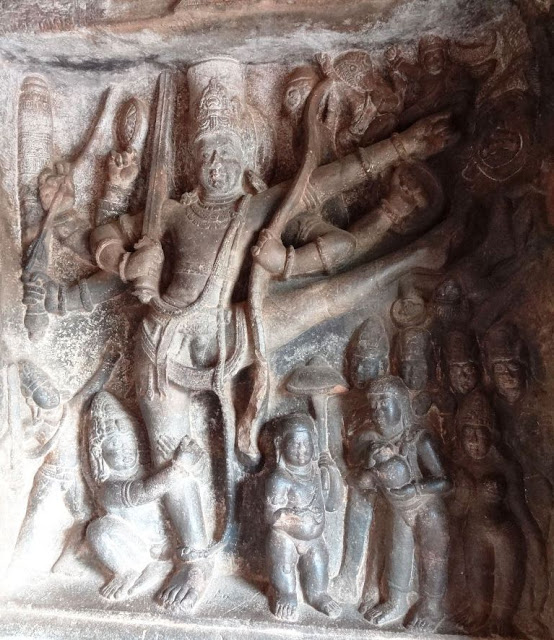 |
| Trivikrama Panel |
There are also many sculptures on the roof of the second
cave temple. One of them is of special interest. It is an infinite maze.
There is not starting and ending point for this maze. Also there are sculptures
depicting the churning of the milky ocean.
 |
| Roof sculpture of infinite maze |
As I climbed the stairs leading to the third cave temples, I
found myself in a spacious courtyard. Looking down from this point in the hill,
one can see a panoramic view of the Agastya lake and the red sandstone cliffs
of Badami. It was a lovely view.
Agastya is an artificial lake, which is very ancient. Historians believe that the Chalukyas themselves had dug out the Agastya lake and built the stone steps leading to it. Our guide also told that Chalukya workmen reused the stone pieces that was carved out while creating the cave temples to build these steps. From this courtyard, I had a good look at the third cave temple.
 |
| Panoramic View of Agastya Lake |
Agastya is an artificial lake, which is very ancient. Historians believe that the Chalukyas themselves had dug out the Agastya lake and built the stone steps leading to it. Our guide also told that Chalukya workmen reused the stone pieces that was carved out while creating the cave temples to build these steps. From this courtyard, I had a good look at the third cave temple.
Badami Cave temple 3 - Vishnu temple
 |
| Badami Cave Temple - 3 |
Third cave temple is
the largest and most decorated. Historically
this temple is very important as there is an inscription found inside this
temple attributing its construction to Mangalesha- the third king of Chalukya
dynasty. The year and day of consecration of this temple is also clearly
marked. It is equivalent to the full moon day of 1st November in AD
578. In fact, the date was written in Saka year.
Bas-Relief 1 - Garuda on the eave of the temple
The first striking sculpture of the third cave temple is
located on the eave next to the entrance of the cave temple. It is the
sculpture of Garuda. Garuda is an eagle
in human form. According to Hindu mythology, Garuda is the vehicle of Vishnu
and it is customary of Hindu temples that the vehicle of the main deity is
carved just outside the main sanctum.
 |
| Garuda in Badami Cave temple 3 eave |
Bas-Relief 2 - Vishnu sitting on Sesha-Naga
The first corridor of the cave temple so much ornate that it
resembles nothing less than a royal court. At one end of this corridor, stand
the iconic image of Badami. It is a sculpture of lord Vishnu sitting on top of
the coils of serpent “Shesha”.
There are no words to describe the beauty of this sculpture. It is also enhanced by the intricately carved pillars on both sides. Next to the Vishnu sculpture, there is also a sculpture of Varaha. It is almost same as the sculpture we saw in the second cave temple.
 |
| The iconic image of Badami - Vishnu sitting on Shesha Naga the serpent |
There are no words to describe the beauty of this sculpture. It is also enhanced by the intricately carved pillars on both sides. Next to the Vishnu sculpture, there is also a sculpture of Varaha. It is almost same as the sculpture we saw in the second cave temple.
On the other side of the corridor, there is an equally
stunning sculptural panel depicting “Narasimha” another avatar of Lord Vishnu.
Narasimha is depicted with four hands and heavily leaning on a club, which is
broken now.
 |
| Narasmiha sculpture |
There is also a very clear depiction of Harihara in this
cave temple.
Apart from these magnificent sculpture panels, the roof and pillars of the cave temple is also decorated with sculptures and decorative carvings. The top portion of the pillars are adorned with sculptures of common people of Badami. Some of the interesting pillar sculptures are below.
Carved on to the pillars facing each other, there is a depiction of a royal couple and a working class couple. The financial status of each of these couple is evident from the type of cloths and ornaments. The working class has cloths only till the knees, which enable them to work in the fields. The ornaments of the working class are also very simple. The royal couple is characterized by full length dress, with heavy ornaments including anklets. Their dress seems to be made of fine cloth and embroidered.
Apart from these magnificent sculpture panels, the roof and pillars of the cave temple is also decorated with sculptures and decorative carvings. The top portion of the pillars are adorned with sculptures of common people of Badami. Some of the interesting pillar sculptures are below.
Bas relief 4 (Minor) Royal and working class couple
Carved on to the pillars facing each other, there is a depiction of a royal couple and a working class couple. The financial status of each of these couple is evident from the type of cloths and ornaments. The working class has cloths only till the knees, which enable them to work in the fields. The ornaments of the working class are also very simple. The royal couple is characterized by full length dress, with heavy ornaments including anklets. Their dress seems to be made of fine cloth and embroidered.
 |
| The Royal couple on left - The working class couple on right |
Badami Cave temple 3 - Bas relief 4 (Minor) - A couple in mangrove
There is a sculpture of a couple,
who seems to be in love. They are spending time in the mangrove. There are
smaller figures by the foot of the couple, probably a symbol for cupid.
 |
| A couple in love |
Bas relief 5 (Minor) - The drunk women and her husband
This hilarious sculpture depicts
the scene that a woman has passed out after drinking too much of local alcohol
and a man (possibly her husband) helping her to get on her feet. She had
vomited and there is a dog licking the vomit at her feet. This sculpture was of special interest as it
also shows the cultural setting of olden days Badami. As many sculptures
depicts, women had a very strong presence in the daily life and temple
activities.
The sculptural panels on the ceiling of the third cave temple are also very interesting. They depict Brahma, Kubera, Varuna, Shiva-Parvati, Indra etc.
 |
| The drunken women and her husband |
The sculptural panels on the ceiling of the third cave temple are also very interesting. They depict Brahma, Kubera, Varuna, Shiva-Parvati, Indra etc.
Lost murals of Badami cave number 3
Another striking feature of the third cave temple is that,
it had mural paintings all over the walls. Unfortunately, due to lack of
protection they have all vanished. Our guide told that in the early days of
discovery of this temple, chemical wash was performed to clean the temples, and
much of the destruction of the murals are attributed to this unscientific act. If
the mural existed, then the cave temple 3 would have been nothing less than a
world wonder. There is some color left on some parts of the murals. Also, in
the archaeological museum of Badami, there is reconstruction of the these murals. It is indeed a disappointment for any art lover.
 |
| A small part of surviving mural on the Badamai cave temple 3 |
There stone inside this temple is naturally adorned with
purple veins running along them. It is the specialty of only this cave temple.
Our guide is of the opinion that, this area of the mountain with such beautifully
designed stones might have been reserved for making such a stunning cave
temple.
 |
| Purple veined stone in Badami cave temple |
Badami Cave Temple 4 - Jain Temple
The fourth cave temple of Badami is quite different from the
others in the group. It is a Jain temple. Even though the Chalukya kings were Vaishnavas,
many of their subjects were Jains. Religious tolerance was one of the main
principles of Chalukya rulers. So, they created the fourth Jain temple in order
to accommodate the Jain population in their Kingdom. However, the fourth cave
temple is situated inside a high wall. I asked the guide about it. Many of the
Jain sages were “Digambars” meaning, they were practicing nudism. So, it might
be uncomfortable for the Hindu religious if they happen to see these Jain
sages. Also vice versa. Hence it was thoughtful on the part of Chalukya kings
to include this high wall in their construction.
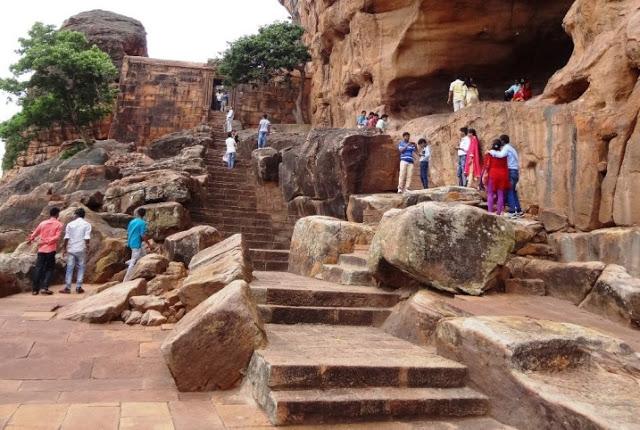 |
| The high wall leading to the Badami cave temple 4 |
The fourth cave temple is much smaller than the third one. The
primary deity of the fourth cave temple is Mahavira. As we enter into the cave
temple, on the right side there is a sculpture of Parshwnatha – the twenty
second Thirthankara of Jainism. He is identified by the five hooded serpent
over his head. In the sanctum, there is an idol of Mahavira. Mahavira was
the last Thirthankara of Jainism. According to Jain beliefs, a Thirthankara is
a great teacher. He is identified by seating position and triple parasol over
his head.
 |
| Parshwanath on left and Mahavira on right |
There is also a magnificent sculpture of Bahubali – a Saint
in Jainism. During my visit to the fourth cave temple, I came to know about a
ritual in Jainism named “Santhara” or “Sallekhana”. It is kind of a fasting
unto death. The devotee who enters the “Santhara Vrutha” doesn’t take any food
or water and believe to attain Moksha. There was a huge controversy over this
ritual as Rajasthan High court banned it. The court sited that this ritual is
equivalent to suicide. However later on, Honorable Supreme court of India
removed this ban. There is an image of a
lady in the fourth cave temple, who has believed to attain Moksha by performing
“Santhara”.
 |
| Sculpture of Bahubali |
It was almost 3 hours we were roaming around in the cave
temples. Our guide did a great job explaining us the archaeological and
religious importance of the Badami cave temples. He charged five hundred rupees
for 3 hours. However, I felt that it was worth every penny. I walked around an
clicked a few photos of the Agastya lake and that of the Lower Shivalaya. Thankfully, none of the monkeys took
particular interest in us. We bid goodbye to the cave temples by noon and
proceeded with the next items in our itinerary.



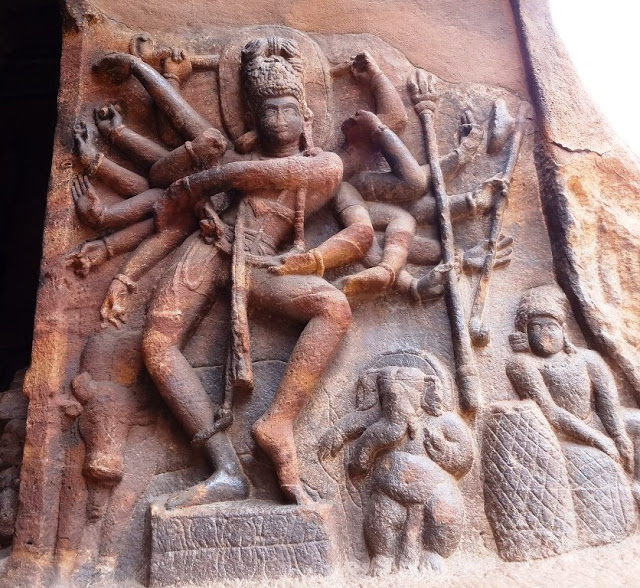



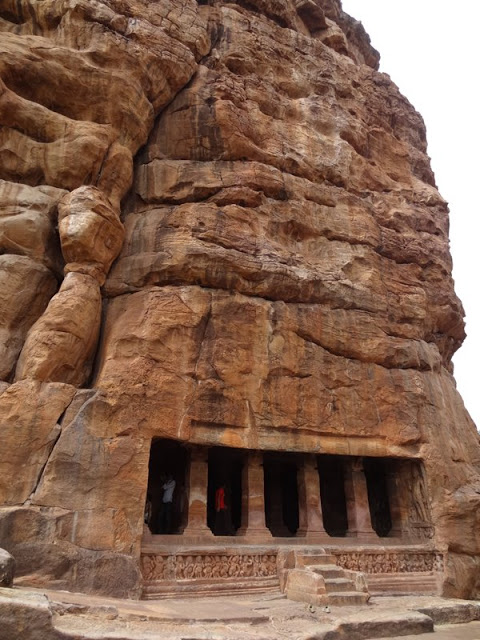


Wonderful writing !
ReplyDeleteBeautiful images, you must be fast enough to capture em all.
ReplyDeleteFantastic! well written with beautiful pictures... after reading this, I would plan to visit this place.
ReplyDeleteThe key difference between online roulette and reside roulette is that the latter features a supplier, whereas standard online roulette makes use of RNG expertise. Online roulette is a computerized version of the on line casino sport roulette. Players place chips on numbers between zero and 36 온라인카지노 which may be coated individually or by putting bets masking a spread of numbers. The Labouchère System is a progression betting technique just like the martingale but does not require the gambler to threat their stake as rapidly with dramatic double-ups.
ReplyDeleteबहुत ही शानदार, बादामी गुफ़ा से संबधित सभी तथ्यों का अद्भुत संगम।
ReplyDeleteबहुत बहुत धन्यवाद आभार।
Post a Comment